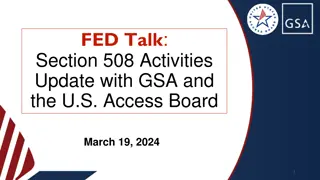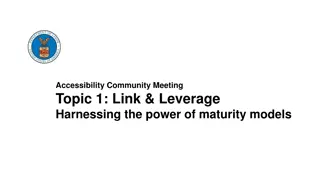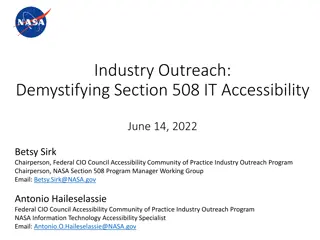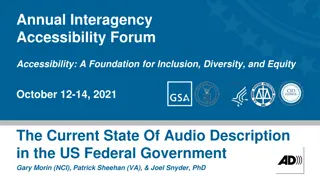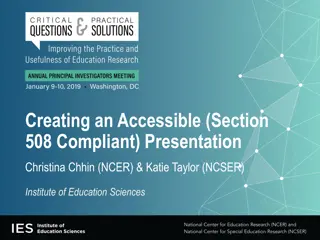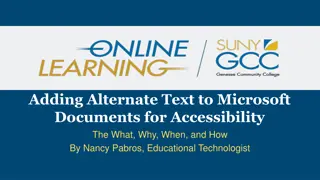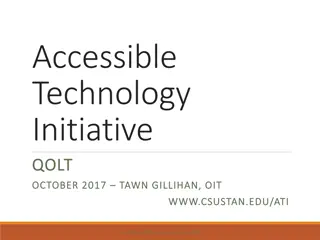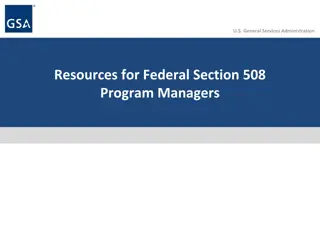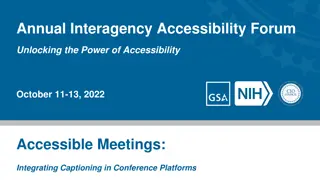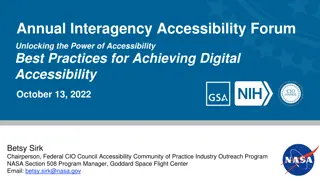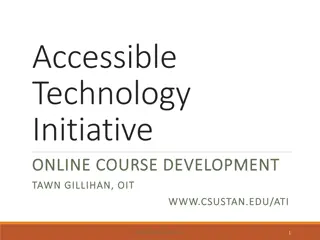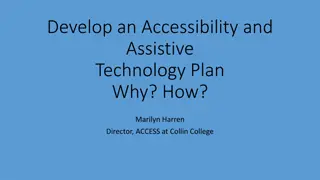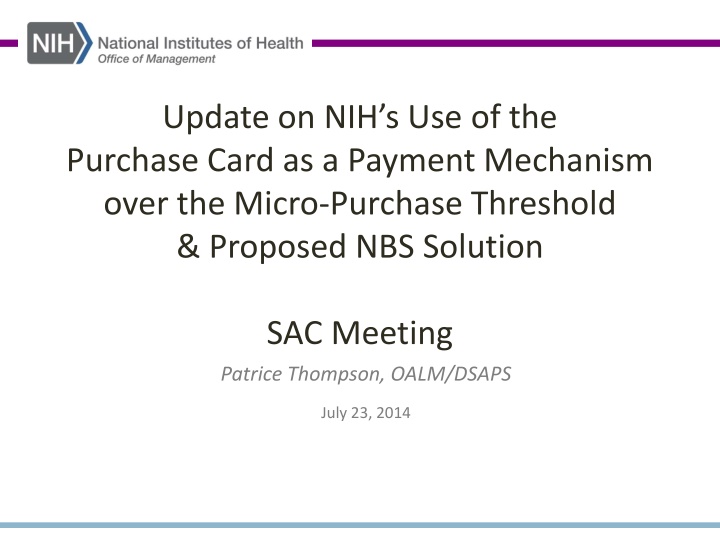
Update on NIH's Purchase Card Use & Federal Acquisition Regulations
This document provides an update on the use of purchase cards at NIH over the micro-purchase threshold, with a focus on proposed solutions and the impact on the community. It discusses general acquisition requirements, federal acquisition regulations, and the need for proper reporting to DCIS. Challenges and suggestions for improvement are highlighted, emphasizing the importance of leveraging purchase cards as both ordering and payment mechanisms within contractual agreements.
Download Presentation

Please find below an Image/Link to download the presentation.
The content on the website is provided AS IS for your information and personal use only. It may not be sold, licensed, or shared on other websites without obtaining consent from the author. If you encounter any issues during the download, it is possible that the publisher has removed the file from their server.
You are allowed to download the files provided on this website for personal or commercial use, subject to the condition that they are used lawfully. All files are the property of their respective owners.
The content on the website is provided AS IS for your information and personal use only. It may not be sold, licensed, or shared on other websites without obtaining consent from the author.
E N D
Presentation Transcript
Update on NIHs Use of the Purchase Card as a Payment Mechanism over the Micro-Purchase Threshold & Proposed NBS Solution SAC Meeting Patrice Thompson, OALM/DSAPS July 23, 2014
Agenda Requirements and Background Actions taken to date Proposed process Next steps Impact to Community 2
General Acquisition Requirements Type of Purchase Dollar Amount Requirements Under the MPT (Micro- purchases) Generally $3,000 and below $2000 for construction (Wage Requirements) $2500 (Service Contracts Labor Standards) -May be awarded without competition if price is fair and reasonable Simplified Acquisition Generally Above $3,000 and up to $150,000 -Competition or Sole Source justification -Public posting for purchases over $15,000 -Price is fair & reasonable -Contractor must be in SAM and cannot be on excluded party list -Small business consideration Fixed by this solution: -Use of appropriate provisions and clauses (manual process) -Reporting to DCIS (Can be higher for some types of acquisitions) Contract Over $150,000 - Above with additional regulations 3
Federal Acquisition Regulations Issue 1 FAR 4.6 requires that purchases over the micro-purchase threshold (MPT) be properly reported to DCIS with unique Procurement Instrument Identification (PIID). Allows data to be captured for HHS/NIH small business goals. A means of measuring and assessing the effect of Federal contracting on the Nation's economy and the extent to which small, veteran- owned small, service-disabled veteran-owned small, HUBZone small, small disadvantaged, women-owned small business concerns, and AbilityOne nonprofit agencies operating under the Javits-Wagner-O'Day Act, are sharing in Federal contracts. Status: There is no current capability within Oracle iProcurement purchase card function to report actions into DCIS without incurring a double obligation. The current systems do not allow a PO or contract to be created and paid by using a purchase card. Issue 2 FAR 13.301 states that agencies should encourage use of the card in greater dollar amounts by COs to 1) place orders and pay for authorized purchases against contracts (under FAR 8), and 2) Place orders and/or make payment under other contractual instruments, with contractor agreement. Status: Review of purchase card transactions over the MPT shows the purchase card is being used as an ordering mechanism NOT a payment mechanism. The pcard must be used as a payment mechanism against a contractual instrument that has specific terms and conditions which protect NIH. 4
Federal Acquisition Regulations (continued) 32.1108 Payment by Governmentwide commercial purchase card. (a)The clause at 52.232-36, Payment by Third Party, governs when a contractor submits a charge against the purchase card for contract payment. The clause provides that the contractor shall make such payment requests by a charge to a Government account with the third party at the time the payment clause(s) of the contract authorizes the contractor to submit a request for payment, and for the amount due in accordance with the terms of the contract. HHS Purchase Card Program Guide v. 6.0 The Department requires that all contract actions made with the purchase card over the micro- purchase threshold ($3,000) be reported in the Departmental Contract Information System (DCIS). The DCIS provides a single system capability within HHS that collect, edits and stores information on individual procurement and contracting actions executed by the OPDIVs and other HHS offices. It forms a HHS-wide database of the collected information; forwards selected information about HHS procurement and contracting actions reportable under Public Law 93-400 to the Federal Procurement Data System (FPDS). DCIS also provides readily available HHS specific reports on selected contract actions. Additional information can be found on the DCIS site. 5
Background In FY 2013, 7,562 purchases over MPT were made using the purchase card totaling approximately $60M. Acquisition personnel are making 50% of these types of purchases (series 1105 and 1102) Nearly 37% of these purchases are being made on the administrative side (series 341 and 301) Preliminary findings based on current data indicate: Roughly 250 NIH purchase cardholders have warrants and a single purchase limit that allows them to make payments using their purchase card over the MPT To obtain a warrant, employees are required to: SAC-A: $25,000 warrant CON 237 Advanced Simplified Acquisition Procedures Appropriations Law Simplified Acquisition & Delegated Procurement Green Purchase training SAC-B: $150,000 warrant Plus SAC-A training CON 100 CON 110 1105: Purchasing (41.2%) 341: Administrative Officer (28.2%) 1102: Contracting (9.2%) 301: Misc. Admin (8.4%) 303: Misc. Clerk/Admin (5.0%) 343: Management Analyst (3.8%) 6
Warranted Cardholders at NIH IC CC CIT CSR FIC NCATS NCCAM NCI NEI NHGRI NHLBI NIA NIAAA NIAID NIAMS NIBIB NICHD NIDA NIDCD NIDCR NIDDK NIEHS NIGMS NIMH NINDS NINR NLM OD ORF ORS Grand Total Warranted Cardholders 25 3 1 1 4 1 50 4 7 9 7 3 11 5 2 9 3 4 5 4 4 3 6 14 2 5 22 9 24 247 There are currently 1500+ cardholders. It is estimated that 90% of the warranted cardholders also have PRISM access. 7
FY13 Awards & Payments Paid via Purchase Card over $3K Total trans over $3K Amount CC 1632 CIT 119 CSR 57 FIC 21 NCCAM 12 NCCATS 253 NCI 930 NEI 249 NHGRI 299 NHLBI 508 NIA 26 NIAAA 221 NIAID 110 NIAMS 153 NIBIB 109 NICHD 21 NIDA 85 NIDCD 167 NIDCR 180 NIDDK 302 NIEHS 104 NIGMS 33 NIMH 304 NINDS 373 NINR 46 NLM 145 OD 304 ORF 184 ORS 615 Grand Total 7562 Sum of Total Transaction IC $16,030,636.01 $642,293.84 $436,230.21 $109,749.45 $72,802.53 $2,350,291.33 $6,845,721.57 $2,013,888.57 $2,304,151.16 $4,077,534.38 $225,077.02 $1,656,122.17 $706,736.33 $1,151,799.15 $1,118,696.64 $112,122.82 $525,613.58 $1,211,764.64 $1,294,884.37 $2,003,180.19 $690,751.22 $211,943.60 $2,052,396.18 $2,747,256.91 $426,250.26 $1,314,516.01 $2,489,529.75 $1,735,308.64 $4,312,659.53 In FY14 YTD, as of May there were 4285 purchases over MPT that were awarded and paid using the purchase card totaling $34M. $60,869,908.06 8
Solution Requirements: 1. Proper acquisition policy and procedure be applied to each buy 2. Issuance and signature on a proper written instrument with clauses 3. *Reporting via DCIS by generating the required PIID (system process) 4. Use of the purchase card to make payment against the contractual instrument *Because of timing constraints, phase 1 will be implemented July 2014 (now scheduled for early Aug) and will focus on #3. Additional phases will address some of the manual processes. 9
Summary of Actions taken to Date NBS worked with OALM to look at possible solutions/Impact on Community. Presented to SAMPC and OM in May to discuss proposed solution. Decided to develop NIH system solution in Oracle for making awards and payments over MPT using the purchase card. Allows NIH to be compliant and continue use of purchase card as payment mechanism. Agreed to proceed in order to implement by late July 2014 (now postponed to early Aug). Since then, NBS began working on the project and collaborating with OALM on solution and implementation schedule, met with HHS/DCIS team to ensure solution would address requirements and established weekly team meetings 10
Summary (continued) OALM/NBS holding regular IC working group sessions to review issues, create a simplified process for PO forms and distribution of terms & conditions. Due to timing constraints, solution will be implemented in phases. Presentations made to IC Coordinators, SAMPC, EOs, and NBS Change Advocates. Initial communication sent to cardholder community with general information on the upcoming changes. User Acceptance Testing (UAT) held July 16th. UAT Testers include NCI, ORS, NIAID, NHLBI, and NHGRI Proposed Go live functionality available to the community on August 11 (previously July 28) 11
Next Steps More detailed communication will be sent for warranted cardholders and CAOs who are directly impacted by this system change. Training on DCIS and system changes will be scheduled late July and early August for warranted cardholders and CAOs. NBS will provide step by step navigational documentation. After system solution implemented, working group will look at simplifying the manual process to include leveraging Document Generation System (DGS) clauses/forms; using a standard form across NIH; providing proper job aids; training; ensuring separation of duties; etc. Phase I (Aug 2014) Fall 2014 Phase II/Long Term Simplified Acquisition Refresher Training for warranted cardholders and CAOs Standard checklist Standard forms for purchase orders (SF30 or SF1449) OALM/NBS to review process and streamline where feasible. Continue to work with NBS for future enhancements. PO generation with terms and conditions in Oracle Referenced PIID validation and reporting Modification to AMBIS/POTS Enhanced Oracle or PRISM solution for award and payment integration in one acquisition system DCIS reporting as POs PIID generation Capture referenced PIID for internal reporting purposes Link to DGS to generate terms and conditions Manual process for creating purchase order 12
General Acquisition Flow Develop Acquisition Strategy/Purchase Request Solicitation Evaluation Acquisition Planning Issue Signed Award PCard Log Finalize DCIS Award Receive, Inspect, and Accept Goods or Services Issue payment by PCard Post Award 13
Purchase Care Logs Over 3K and DCIS Reporting Proposed Process 14
Impacts Immediate and Potential All cardholders and CAOs will see updated screen; however, will only access certain fields for purchases over MPT. DCIS entry will add additional time to each order. Data being reported to DCIS will be reported as a purchase order. Users will need to ensure vendors are in SAM prior to log creation. If vendor is not in SAM (e.g. foreign merchants), NBS is still solutioning. Currently will be handled on an exception basis thru NBS Help Desk tickets. Maybe some additional manual efforts required for AMBIS/POTS users. Manual process still needed for some portions of the acquisition process such as developing the purchase order; generating terms and conditions; sending information to vendor; separation of duties, etc. Next phase will look at how to streamline and address compliance. Concern expressed from IC Coordinators that many of these orders may shift to the COAC. 15
Concerns Not a simple process initially Duplication of work manually having to create a purchase order even though some of the info was already entered online. Timing of implementation Refresher training needed as well as systems training Modifications currently an issue but NBS is working on this Vendors not in SAM (e.g. foreign merchants) will be handled on exception basis. Some IC Coordinators believe orders may shift to COAC as a result. If so, workload on COAC will be an issue. PMAPS for some purchasing agents have processing time metrics. May need to be adjusted. 16
Questions? 17


